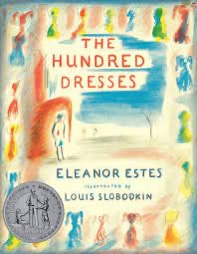Blog Post 24
February 27-March 3
Learning Outcomes
English Language Arts:
-I can write or represent meaning of text in different forms.
-I can use grammatical structures, verb tenses, and conventions in my own writing, and apply a variety of strategies to assist with my spelling.
What Did Students Do?
We met together as a large group and read the first chapter of the book, The Hundred Dresses by Eleanor Estes. We then discussed our task of creating a podcast based on our summaries of the chapters of the book. Mrs. Sampson gave students an example of a podcast summary to show them what was expected of them. She then played her sample podcast and students shared feedback on what was good and what could be done to improve the podcast. "You should read more quickly at the beginning so it doesn't sound creepy." That was definitely a favourite suggestion and the student wasn't wrong. After all feedback was given and it was determined that Mrs. Sampson should stick to teaching rather than podcasts, students were split into three groups with their literacy teachers, Mrs. Sampson, Mr. Pearson, and Ms. Prediger. Students then reread chapter one both as a large group and in small groups, summarizing, predicting, questioning, clarifying, and making connections. They wrote their own podcasts for chapter one, using a rubric, a C.O.P.S. checklist, and their personal spelling dictionaries. After receiving feedback on their podcast, they will get to record it on Monday and Tuesday. We will continue writing and recording these podcasts until we head off for Spring Break. Students will continue to read and receive feedback in their small groups of five students with a teacher. Their last podcast will be done independently and will be their formative assessment on this task.
Family Connections
Ask your child:
-What happened in chapter one of The Hundred Dresses?
-What do you predict the rest of the book will be about?
-Where do you think Wendy is?
-How was the language in the book different than language we use today?
Coming Up
-Wednesday, March 8th - School Council Meeting - All parents are welcome and encouraged to attend these meetings.
-Thursday, March 9th & Friday, March 10th - Conferences - Please sign up for a time. We would like to see all parents. Please allow extra time for your child to show you all of the amazing things we are doing in grade five. We will have other families in the classroom during our conferences so if you have sensitive things you want to discuss please let me know and we can book an alternate time or location.
-March 13 - 17th - Trickster Residency
-March 16th - Evening performance of Trickster - Please plan to join us for these performances. If you have children performing in both time slots, you are welcome to leave siblings in their classrooms as teachers will be available for the entire evening.
-March 25th - April 2nd - SPRING BREAK! No school for students or staff. Classes resume on April 3rd.

Comments
Post a Comment